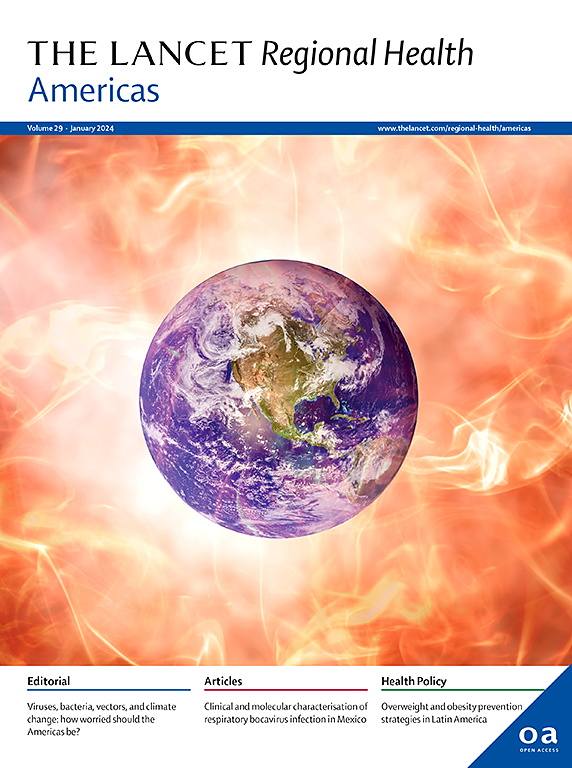Characterisation of the respiratory syncytial virus seasonality and its environmental factors in the Americas—a multi-country observational study using routine surveillance networks
IF 7
Q1 HEALTH CARE SCIENCES & SERVICES
引用次数: 0
Abstract
Background
Respiratory Syncytial Virus (RSV) is an important cause of bronchiolitis and pneumonia in young children. Circulation patterns represent challenges for immunoprophylaxis, requiring tailored interventions to address RSV activity linked to climate. We assessed RSV seasonality across the Americas and its relation to environmental factors and influenza circulation.
Methods
RSV seasonality was assessed using data reported in 2010–2019 to a multi-country respiratory surveillance network. Time-series analysis identified temporal patterns and trends. Negative binomial, Moving Epidemics Method, and WHO Moving Averages Models were compared to assess seasonality. Correlation and regression were used for associations of RSV with environmental and influenza predictors.
Findings
During 2010–2019, 32 countries in the Americas reported 14,308,503 respiratory samples, with 446,648 RSV-positive (3.12%) samples. RSV seasonal epidemics progressed from south to north. In South America, RSV seasons began in early May, peaking in August. RSV seasonality was less distinct in Caribbean; RSV started in September and peaked in October–November. Central Americas’ RSV season lagged behind influenza, whereas in the Andes, it peaked earlier. At higher latitudes, RSV epidemics occurred earlier with shorter durations. RSV circulation negatively correlated with lower temperatures (−0.43; p < 0.0001), and precipitation (−0.04; p = 0.0035); and was positively correlated with decreased longitude (0.12; p < 0.0001) and barometric pressure (0.15; p < 0.0001), and was associated with lower elevation (0.02; p = 0.10), and westerly locations (0.12; p < 0.0001).
Interpretation
Subregional and interannual variations in RSV seasonality were influenced by environmental factors, underscoring the importance of ongoing surveillance. Collaborative efforts improve surveillance, shaping evidence-based strategies for preventive product introductions and effective RSV control.
Funding
The publication of this work was supported by the United States Centers for Disease Control and Prevention through a cooperative agreement with the Pan American Health Organization/World Health Organization.
美洲呼吸道合胞病毒季节性特征及其环境因素-一项使用常规监测网络的多国观察性研究
呼吸道合胞病毒(RSV)是幼儿毛细支气管炎和肺炎的重要病因。循环模式对免疫预防提出了挑战,需要有针对性的干预措施来应对与气候有关的RSV活动。我们评估了整个美洲的RSV季节性及其与环境因素和流感流行的关系。方法使用2010-2019年多国呼吸监测网络报告的数据评估srsv季节性。时间序列分析确定了时间模式和趋势。对负二项法、移动流行法和世卫组织移动平均模型进行比较,以评估季节性。RSV与环境和流感预测因子的相关性和回归分析。2010-2019年期间,美洲32个国家报告了14,308,503份呼吸道样本,其中446,648份rsv阳性(3.12%)样本。RSV季节性流行由南向北发展。在南美洲,呼吸道合胞病毒流行季节始于5月初,8月达到高峰。RSV季节性在加勒比地区不太明显;呼吸道合胞病毒于9月发病,10 - 11月达到高峰。中美洲的RSV季节落后于流感,而在安第斯山脉,它的高峰更早。在高纬度地区,RSV流行发生得较早,持续时间较短。RSV循环与低温负相关(- 0.43;p & lt;0.0001),降水(−0.04;P = 0.0035);与经度下降呈正相关(0.12;p & lt;0.0001)和气压(0.15;p & lt;0.0001),且与低海拔相关(0.02;P = 0.10),西风地区(0.12;p & lt;0.0001)。RSV季节性的分区域和年际变化受到环境因素的影响,强调了持续监测的重要性。协作努力改善监测,形成以证据为基础的预防性产品引进战略和有效的RSV控制。美国疾病控制和预防中心通过与泛美卫生组织/世界卫生组织的一项合作协议支持了这项工作的出版。
本文章由计算机程序翻译,如有差异,请以英文原文为准。
求助全文
约1分钟内获得全文
求助全文
来源期刊

Lancet Regional Health-Americas
Multiple-
CiteScore
8.00
自引率
0.00%
发文量
0
期刊介绍:
The Lancet Regional Health – Americas, an open-access journal, contributes to The Lancet's global initiative by focusing on health-care quality and access in the Americas. It aims to advance clinical practice and health policy in the region, promoting better health outcomes. The journal publishes high-quality original research advocating change or shedding light on clinical practice and health policy. It welcomes submissions on various regional health topics, including infectious diseases, non-communicable diseases, child and adolescent health, maternal and reproductive health, emergency care, health policy, and health equity.
 求助内容:
求助内容: 应助结果提醒方式:
应助结果提醒方式:


